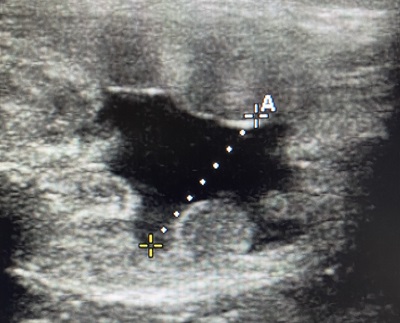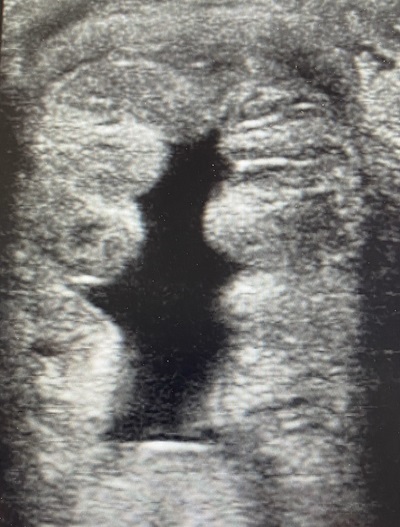 The presence of fluid in the mare’s uterus after natural mating or insemination is a normal event that occurs in response to the breeding. This is the result of an inflammatory response that is needed to rid the uterus of any excess sperm or other contaminating agents. The influx of neutrophils (white blood cells) into the mare`s uterus after breeding results in the elimination of sperm, bacteria and other cellular debris and causes the release of prostaglandins, which stimulates uterine contractions. Typically the inflammatory response peaks 12 hours after breeding and by 24 to 48 hours the mares uterus is empty of fluid. However, some mares are more susceptible to prolonged retention of fluid and it may be retained for several days after breeding.
The presence of fluid in the mare’s uterus after natural mating or insemination is a normal event that occurs in response to the breeding. This is the result of an inflammatory response that is needed to rid the uterus of any excess sperm or other contaminating agents. The influx of neutrophils (white blood cells) into the mare`s uterus after breeding results in the elimination of sperm, bacteria and other cellular debris and causes the release of prostaglandins, which stimulates uterine contractions. Typically the inflammatory response peaks 12 hours after breeding and by 24 to 48 hours the mares uterus is empty of fluid. However, some mares are more susceptible to prolonged retention of fluid and it may be retained for several days after breeding.
There is much confusion as to what causes the accumulation of uterine fluid and the influx of neutrophils after AI with cooled or frozen semen. Some have suggested it is the components of the extender, particularly extenders used for freezing semen. However, research has shown that the inflammatory response is a normal response induced by sperm cells and only becomes abnormal when the inflammation and accumulated fluid last more than 48 hours. One question that repeatedly comes up is whether frozen semen results in greater inflammation than cooled semen or fresh semen.
In most of the studies that have been conducted the inflammation after breeding was not greater for mares inseminated with frozen thawed sperm versus fresh or cool semen.
Barbacini and Squires reported on factors affecting the uterine inflammatory response to semen. They demonstrated that mares greater than 16 years of age have a higher incidence of retained uterine fluid then younger mares. They also reported that barren mares had more uterine fluid versus maiden and foaling mares, thus, if one is breeding older barren mares they may need to be treated for fluid accumulation using uterine lavage or hormones such as oxytocin to assist in the elimination of uterine fluid and improve fertility.
Research has shown that seminal plasma proteins play a critical role in regulating the inflammatory response and some have suggested that removal of seminal plasma when processing frozen stallion semen is the reason why mares accumulate fluid after breeding. However, data suggests that 5% seminal plasma is adequate to control inflammation and most freezing protocols involve retaining at least 5% seminal plasma during processing. More than likely it is the total number of sperm and the concentration of the sperm that results in the inflammation since one can get similar inflammation with mares inseminated with concentrated, fresh semen compared to concentrated frozen-thawed semen. Workers in Finland reported a greater inflammatory response when mares were inseminated with high sperm numbers in a small volume compared to low sperm numbers in a higher volume.
 Very few studies have compared the the inflammatory response after insemination of fresh versus frozen semen. However, workers in Finland conducted a study to determine what the cause of inflammation was after breeding. They evaluated whether the inflammation was due to components of the extender, enzymes from damage sperm or high concentrations of sperm in low volumes.
Very few studies have compared the the inflammatory response after insemination of fresh versus frozen semen. However, workers in Finland conducted a study to determine what the cause of inflammation was after breeding. They evaluated whether the inflammation was due to components of the extender, enzymes from damage sperm or high concentrations of sperm in low volumes.
They concluded that the components of the extender; skim milk, egg yolk glycerol, were not responsible for the inflammatory response and neither were the enzymes released with centrifugation. In this study diluting frozen-thawed sperm in 30 mL of skim milk extender decreased the inflammatory response.
Depending upon the quantity of frozen semen made available, mares are typically inseminated either once or twice per cycle. The advantage of inseminating mares twice in a cycle is that they only have to be examined once per day, similar to management of mares bred with cool semen. However, there are two reasons why breeders may choose to breed only once per cycle: cost of semen when purchased by the dose and fear of a greater inflammatory response with two insemination's per cycle.
Several studies have shown that fertility with frozen semen is the same for mares bred once within 6 hours after ovulation as it is for mares bred twice in the cycle using a timed insemination protocol. Furthermore, the incidence of uterine fluid after breeding is similar for mares inseminated once or twice during a cycle.
In a very interesting experiment, mares were bred twice in a cycle but with semen from two different stallions. The question answered in this study was whether the second insemination (presumably into an inflamed uterus) would result in any fertility. The results of the study indicated that nearly half of the mares became pregnant with semen from the first insemination and the other half with semen from the second insemination.These studies combined demonstrated that at least in normal mares there is no disadvantage to insemination more than once in the cycle if semen is made available.
In summary, uterine inflammation is a normal physiological event that occurs in response to mating or insemination. The sperm cells initiate the response and seminal plasma proteins are important in mediating the duration. Insemination of good quality frozen semen in normal mares does not result in any greater inflammatory response and provides a similar pregnancy rate as cooled semen. When managing older, barren mares with a history of delayed uterine clearance however, one should try to minimize the number of times the cervix is penetrated regardless of the type of semen being used.
See also: Factors Affecting the Uterine Inflammatory Response to Semen
Photos Courtesy of Dr. Erin Newkirk of WellGrove Equine in Florida


Log in to join the conversation.